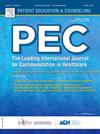Individual difference factors that predict evaluations and acceptance of authorized concealment for the reduction of nocebo side effects
IF 2.9
2区 医学
Q2 PUBLIC, ENVIRONMENTAL & OCCUPATIONAL HEALTH
引用次数: 0
Abstract
Objectives
Authorized concealment is a shared decision-making technique in which a clinician asks a patient if they would prefer not to be informed about all possible treatment side effects, so as to minimize nocebo effects. The present research assessed individual difference variables that predict evaluations and receptivity of authorized concealment.
Methods
A demographically diverse national community US sample of 1012 adults (ages ranging from 18 to 94; M=43.2) learned about nocebo effects and then evaluated and estimated their likelihood of consenting to four possible methods of authorized concealment. A range of self-reported psychological, health, and demographic variables were tested as predictor variables.
Results
The strongest and most reliable outcomes were that greater trust in doctors and a greater desire to avoid side effect knowledge predicted positive evaluations of authorized concealment and estimated personal use of authorized concealment. There was some evidence that women, those of older age, reporting better health, and using medicine more regularly, had a more positive response to authorized concealment, but these effects were dependent upon the specific method of authorized concealment described.
Conclusions
Individual difference variables can predict openness to authorized concealment.
Practice Implications
This knowledge may benefit clinicians who consider employing this shared decision-making technique with patients.
预测为减少反安慰剂副作用而对授权隐瞒的评价和接受程度的个体差异因素。
目的:授权隐瞒是一种共同决策技术,临床医生询问患者是否希望不被告知所有可能的治疗副作用,以尽量减少反安慰剂效应。本研究评估了预测授权隐瞒评价和接受度的个体差异变量。方法:美国国家社区1012名成年人(年龄从18岁到94岁;M=43.2)了解反安慰剂效应,然后评估和估计他们同意四种可能的授权隐瞒方法的可能性。一系列自我报告的心理、健康和人口变量作为预测变量进行了测试。结果:最强和最可靠的结果是对医生的更大信任和更大的避免副作用知识的愿望预测了授权隐藏的积极评价和估计个人使用授权隐藏。有一些证据表明,年龄较大、报告健康状况较好、经常用药的妇女对授权隐瞒有更积极的反应,但这些影响取决于所描述的授权隐瞒的具体方法。结论:个体差异变量可以预测对授权隐瞒的开放程度。实践意义:这一知识可能有利于临床医生考虑采用这种共享决策技术与患者。
本文章由计算机程序翻译,如有差异,请以英文原文为准。
求助全文
约1分钟内获得全文
求助全文
来源期刊

Patient Education and Counseling
医学-公共卫生、环境卫生与职业卫生
CiteScore
5.60
自引率
11.40%
发文量
384
审稿时长
46 days
期刊介绍:
Patient Education and Counseling is an interdisciplinary, international journal for patient education and health promotion researchers, managers and clinicians. The journal seeks to explore and elucidate the educational, counseling and communication models in health care. Its aim is to provide a forum for fundamental as well as applied research, and to promote the study of organizational issues involved with the delivery of patient education, counseling, health promotion services and training models in improving communication between providers and patients.
 求助内容:
求助内容: 应助结果提醒方式:
应助结果提醒方式:


